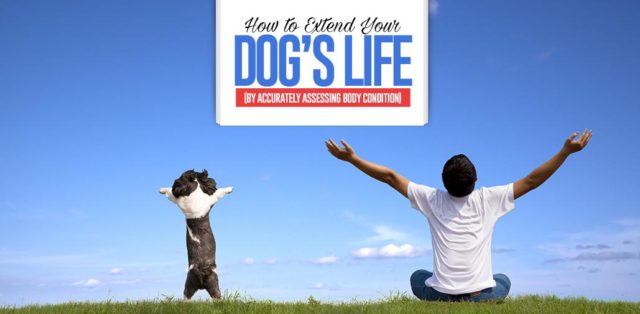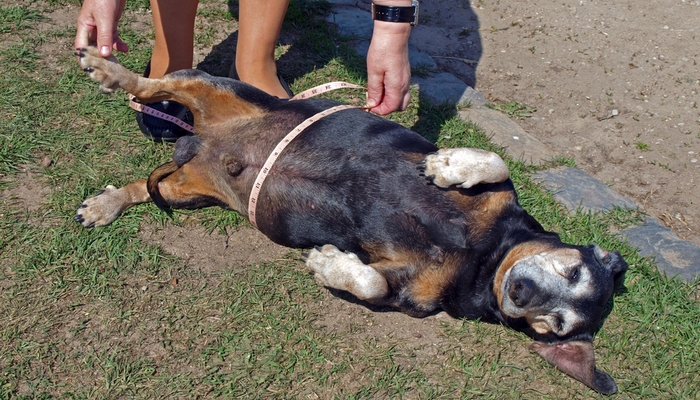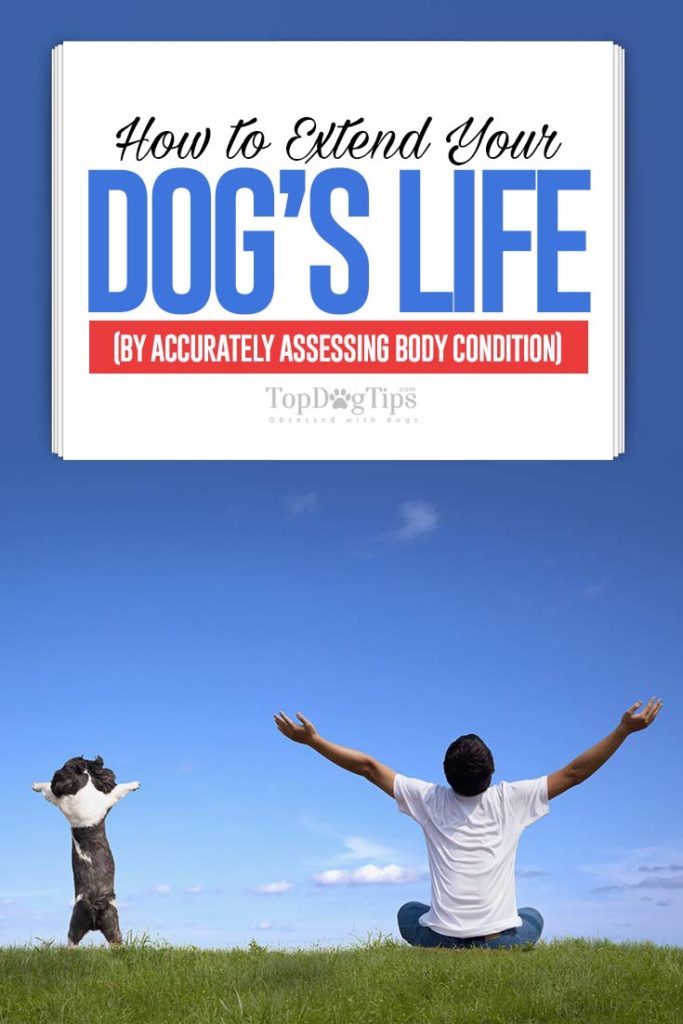
Table of Contents
Poor canine diet often leads to nutritional deficits in dogs, which in turn are strongly related to health complications. You probably know this already, but do you fully understand the extent of damage that these nutritional deficits will have on your dog's long-term health?
The truth is that a poor canine diet can take YEARS off your pet's life. Some studies, like the one showing food restrictions to increase lifespan (1) and then another one that tested diet restriction with Labs (2), for example, have found a direct correlation between feeding dogs and their lifespan. Overfeeding, in particular, leads to shorter life of dogs.
But the problem begins when it comes to describing your own dog’s body condition and understanding where your canine stands in terms of “being in shape.”
Unfortunately, it seems that most people have a wrong idea of what their dog really looks like. We even have more studies that prove that as well. For example, take a look at this study (3), and then this one (4), and this right here (5), and also this paper (6) for more. They all say the same thing: we're very bad at assessing our dogs' body condition and almost deliberately lead them into obesity.
How do YOU assess your dog's body condition?
 Now, take a minute to think about it: would you refer to your dog's current body condition as overweight? Obese? Underweight? Do you believe that your dog is currently at the ideal weight for his age, size, and breed? And what are you basing this assessment on?
Now, take a minute to think about it: would you refer to your dog's current body condition as overweight? Obese? Underweight? Do you believe that your dog is currently at the ideal weight for his age, size, and breed? And what are you basing this assessment on?
A dog's body condition misperception happens when the pet owner's idea of a certain body shape does not match reality. There is even more scientific evidence on how parent’s misperception of their child's body is a major hurdle in treating obesity, thus it's not surprising that the same happens with dogs.
Since parents are unable to acknowledge that their kids (or dogs or cats) are obese, they do not provide them with adequate diet and treatments. More importantly, they avoid food restriction, which would, in turn, improve their health and increase lifespan in dogs.
As the number of pet owners rises in the U.S., more and more veterinarians are seeing the same issue with pets, particularly canine parents. When a vet tells an owner that their dog needs to lose weight, it's not uncommon for the owner to brush the recommendation off. While their dog may be overweight or even obese, a lot of pet owners don't realize it.
The problem is that a lot of pet owners think that the “normal” weight for a dog, according to the Canine Body Condition Score (PDF), is actually too thin. They think that if they can see their pet's ribs, that means they need to increase the daily dog's food ration. Not so.
If your veterinarian wants to discuss your dog's weight, take time to listen carefully. A dog's weight and body condition have an impact on a lot of factors related to your dog's health, not least of which is preventing cancer and arthritis and increasing the dog's lifespan.
Let's discuss the reality of the misperceptions of canine weight and why it is so important.
ASK A VET: How to Put an Overweight Dog on a Diet?
Dog's Body Condition Misperceptions
(and why science says that it matters)
Pet owners often normalize the weight of their dogs
I've thoroughly reviewed the above-mentioned studies (as well as a lot of other research on this subject matter), and now I would like to share some of those findings with you. Hopefully, this will help in making a better assessment of your dog's body weight.
Here's what's very common among pet owners:
When asked to characterize their dogs’ body condition, people tend to normalize the dog's weight. Thus, if their dogs are obese, owners see them as slimmer than they are in reality. If dogs are underweight and, in reality, require weight gain support, people tend to imagine them as having a few extra pounds.
The younger your dog is, the higher the chance that you have formed a wrong image of his body and will likely make a wrong assessment of his body condition.
One study that I mentioned above found that obese or slim dogs between the ages of 4 and 9 years old are more at risk of body misperception by their owners compared with animals between 9 and 18 years old.
Veterinarians and researchers, therefore, stress the importance of early nutritional education among dog owners, which is crucial if you want to improve your dog's health and increase your pet's lifespan.
MORE RESEARCH: How Neutering Dogs May Lead to Cognitive Impairments
The negative portrait of your dog
 Body misperception is common among people, and it stretches into pet ownership, too. People are reluctant to accept their dog has a few extra pounds, the same way parents are unwilling to accept their child is obese.
Body misperception is common among people, and it stretches into pet ownership, too. People are reluctant to accept their dog has a few extra pounds, the same way parents are unwilling to accept their child is obese.
Obesity is negatively represented in the media, so people don’t want to associate their dogs, their cats, or their children, for that matter, with those unfavorable portraits.
But pet obesity has been on a steady rise in the U.S. and the world for decades. Today, Obese dogs account for 22% to 40% of the worldwide (7) dog population.
Lifespan decrease aside, overweight dogs are also more prone to diseases like these:
- diabetes
- arthritis
- cardio-respiratory diseases
- urinary and reproductive disorders
- mammary tumors
- dermatological diseases
- cancer
The list could go on, actually.
Still, even after acknowledging their dog is obese, it appears that owners would rather accept all these factors (8) and deal with obesity-related health implications than rationing their dog’s meals and watching their dog's weight because they can't say “no” to their dogs.
Dogs are programmed to seek food. Every need these dog owners' pets express is interpreted as a request for food, and owners don’t want to deny their dogs such requests, thinking they are doing a good deed. Unfortunately, it's a disservice to the dog.
READ ALSO: The Best Weight Loss Dog Food for Fat Dogs
Preventing and treating obesity in dogs
 The first step to prevent and/or treat canine obesity is to change the way you perceive your own dog’s fitness, shape, and form – what we're talking about in this article.
The first step to prevent and/or treat canine obesity is to change the way you perceive your own dog’s fitness, shape, and form – what we're talking about in this article.
The Canine Body Condition Score (BCS) that I linked to above is the most widely used clinical tool for this purpose. The BCS chart and brochures consist of a series of questions aimed at determining your dog’s abdominal and spinal fat levels and giving you a better idea of where the dog stands.
After answering this series of questions, you will be asked to compare your dog to several pictures and score him on a scale from 1 (very thin) to 5 (markedly obese).
Seeing the pictures of other dogs allows you to have an objective measurement of your own dog’s body condition and not rely on your own idea of what the dog should look like.
While this is a step forward, there are still problems even with pet owners using the Canine Body Condition Score and making an objective assessment.
One of the more recent studies found (3) that even with the help of the BCS chart, dog owners continue to fail to recognize when their dogs are overweight and out of shape.
Thus, veterinarians (or certified canine nutritionists) play a great role in informing owners of their dog’s body condition. To do so effectively, they have to weigh dogs regularly at every vet visit. They also have the duty to inform the owner if their dog is obese.
It is also important to increase public education on companion animals. Obesity programs, which include diet plans for weight loss and weight maintenance, an increase in physical activity, and monthly weight checks, have already proven to be effective (9) in achieving weight loss in dogs.
Particularly, a low-fat, high-fiber dog food diet seems to be the most effective in reducing dogs’ body fat mass and cholesterol levels, according to studies.
Dieting and exercising your canine companion is undoubtedly crucial for weight loss, but everything starts with the way you look at your own dog through the objectivity prism. Don’t ignore those few extra pounds, and increase your dog's lifespan as a result.
Here's a little further reading on this subject and some helpful advice:
- Science-based Canine Athlete Nutrition: How to Feed Athletic Dogs?
- 31 Dog Food and Feeding Myths You Need to Stop Believing Right Now
- How To Slim Down An Overweight Dog + 30 Day Diet Plan
- Understanding Dog Food: Do You Know What’s in There?














